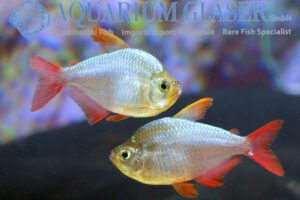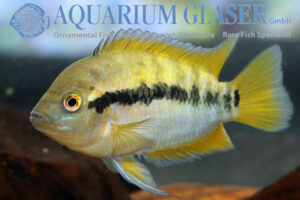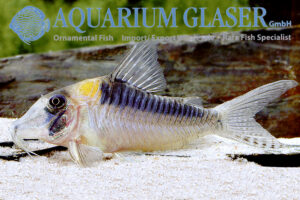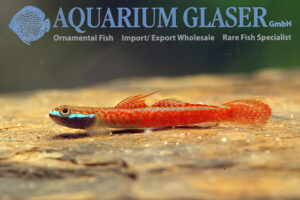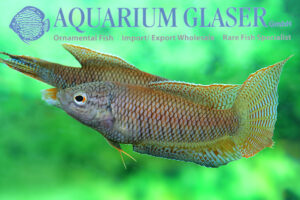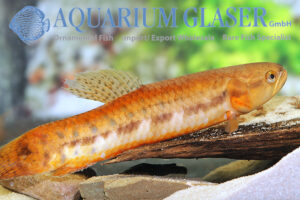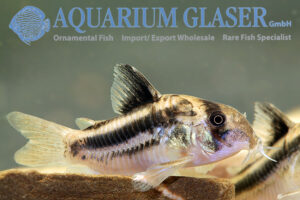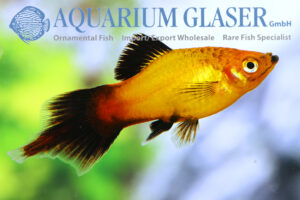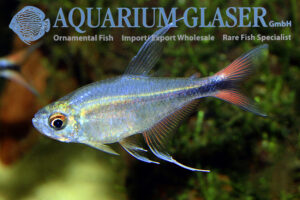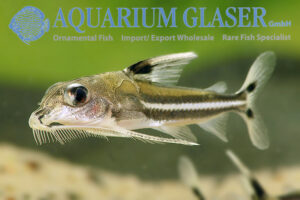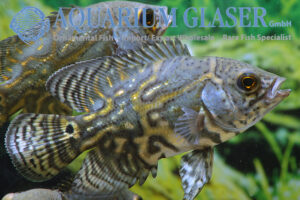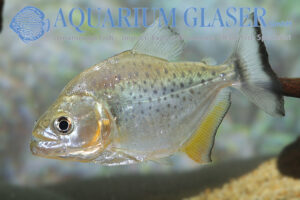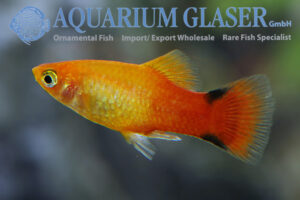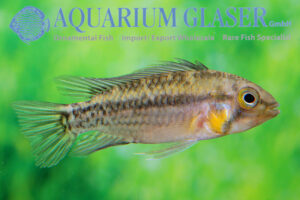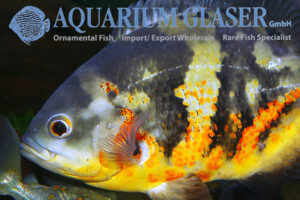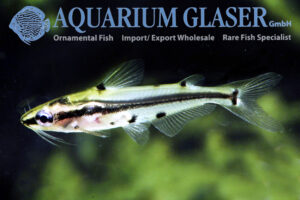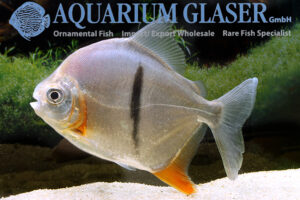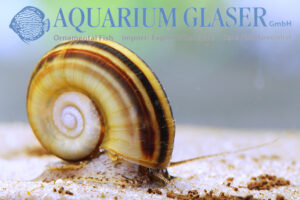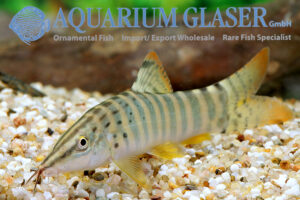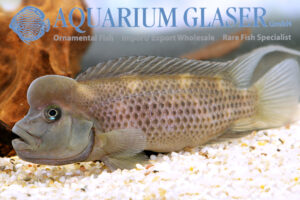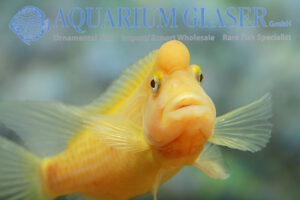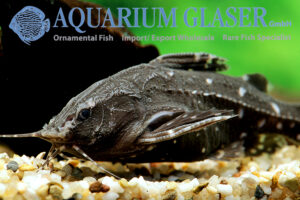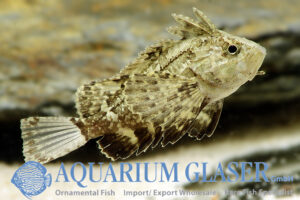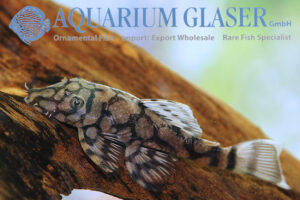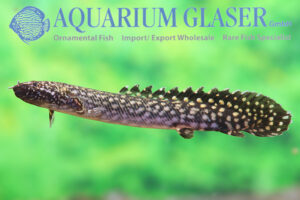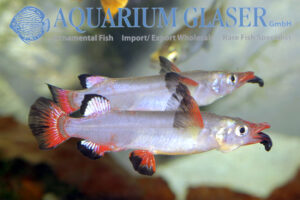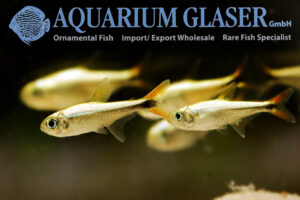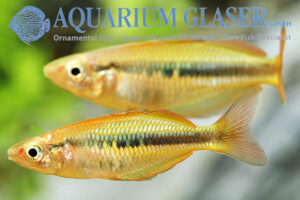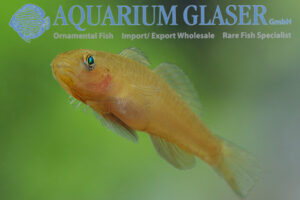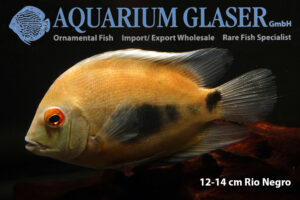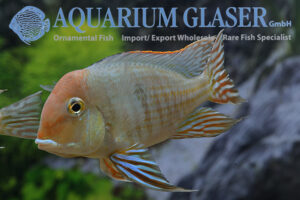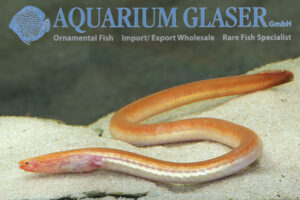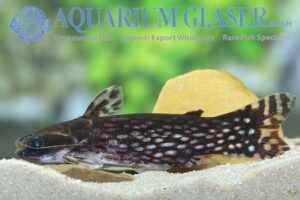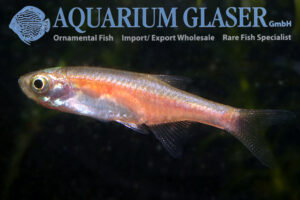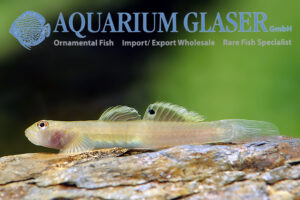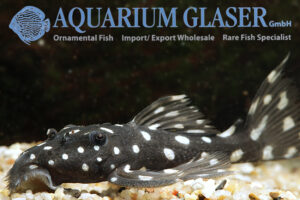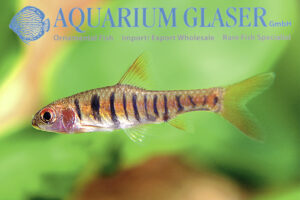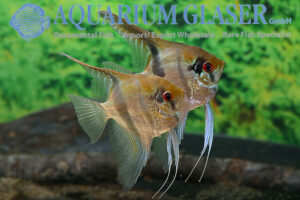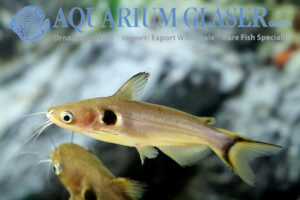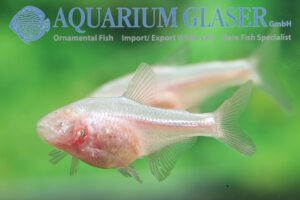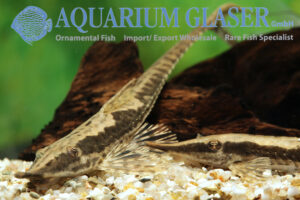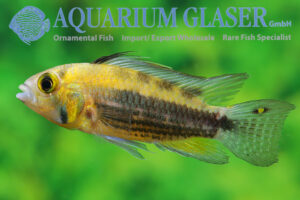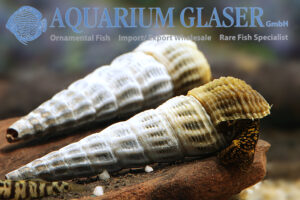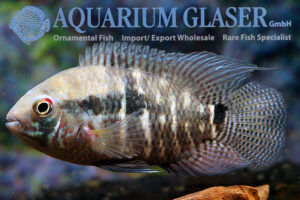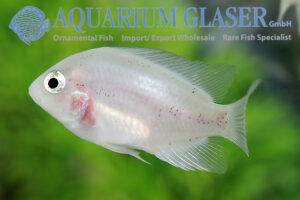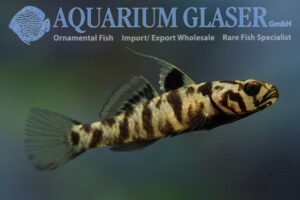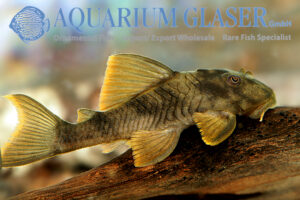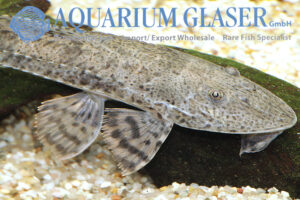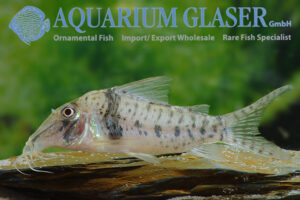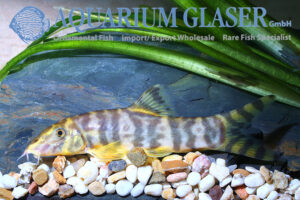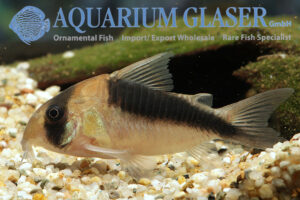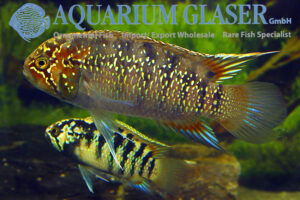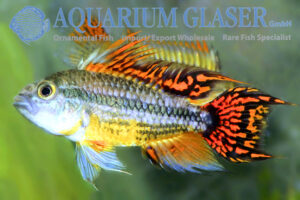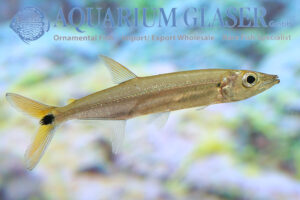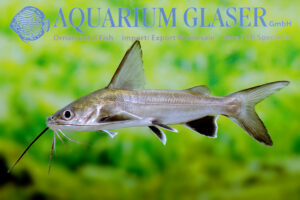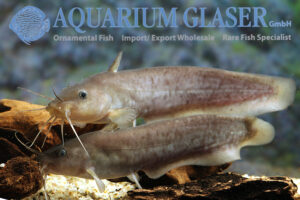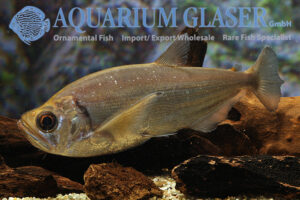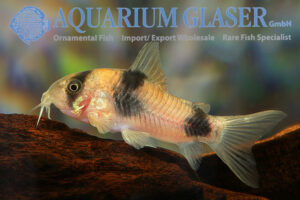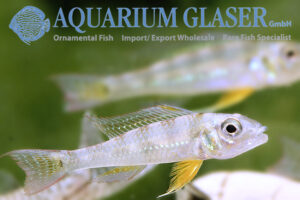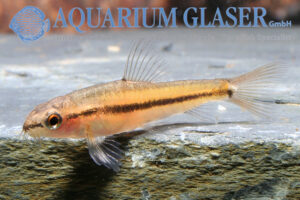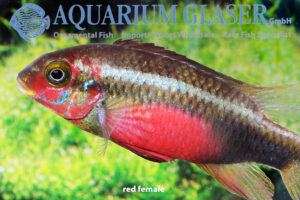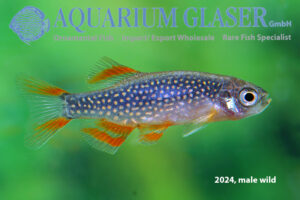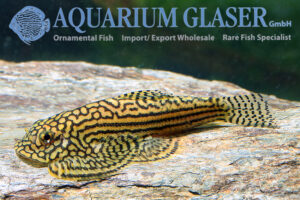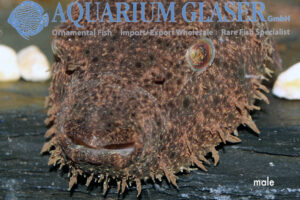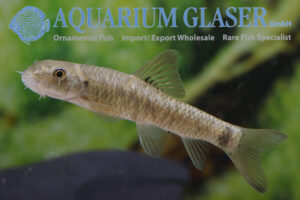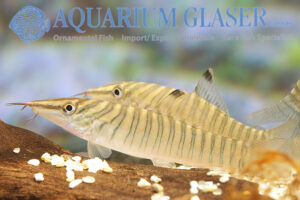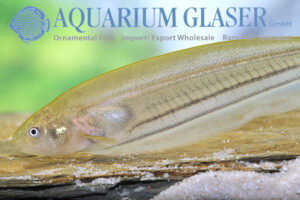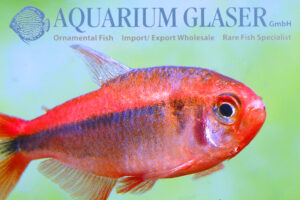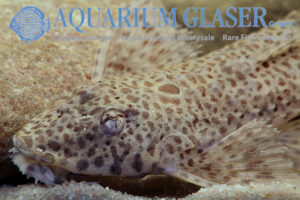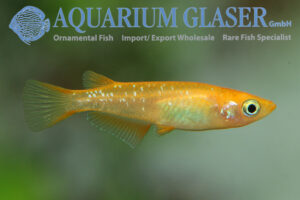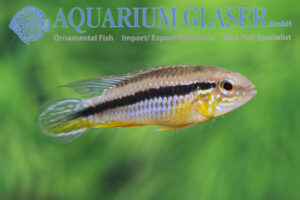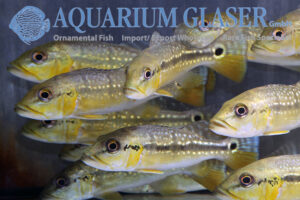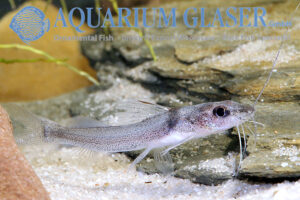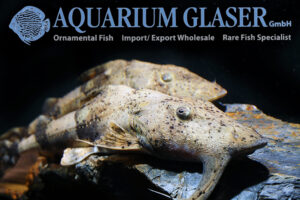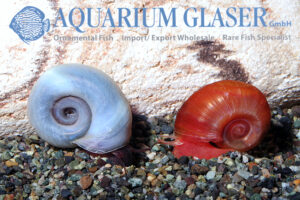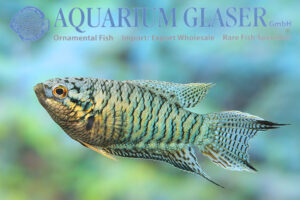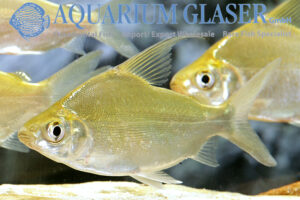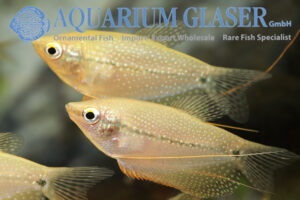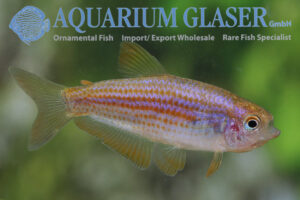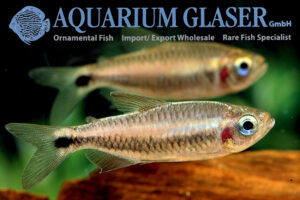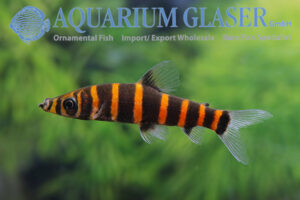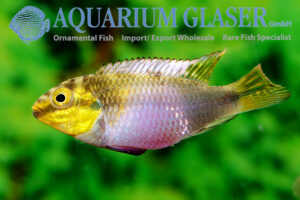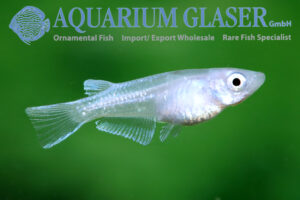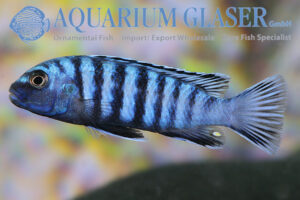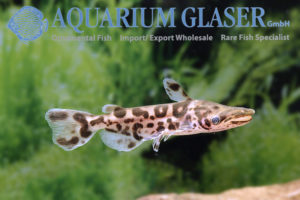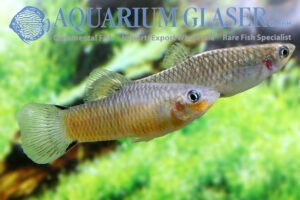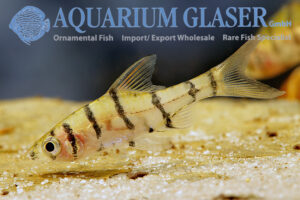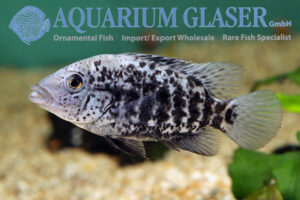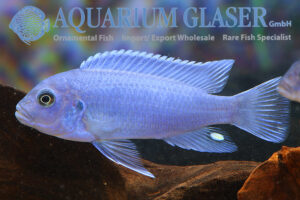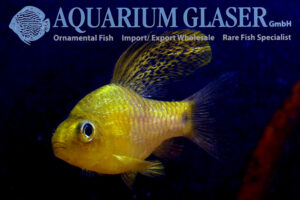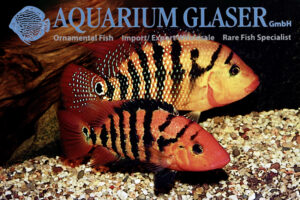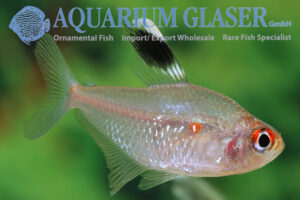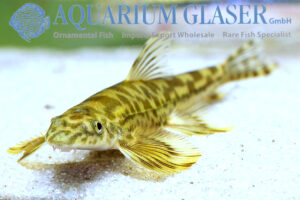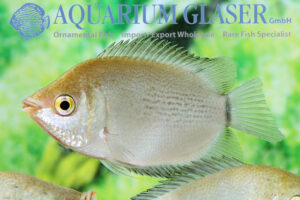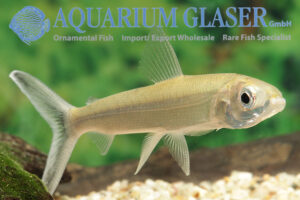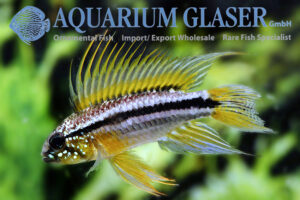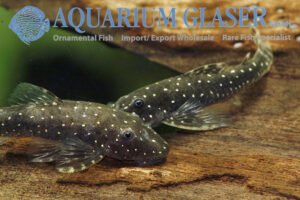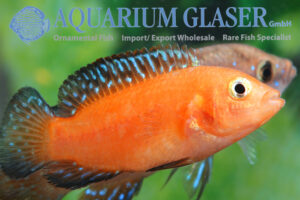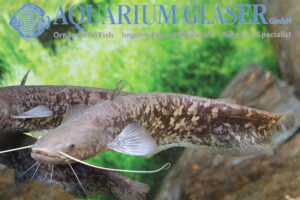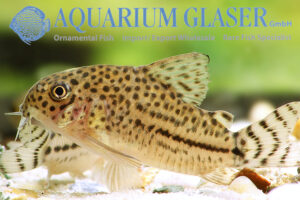Hyphessobrycon columbianus was described by Zarske & Géry in 2001. According to Weitzman, the fish belongs to the “Rosy Tetra group” (in the broadest sense “ornamental tetra relatives”). The first specimens arrived in Germany in 1995, caught in a tributary of the Rio Acanti, Colombia. All specimens currently on the market are said to be […]
Fish Archive (3089)
-
-
Herotilapia multispinosa
This medium-sized cichlid – males can grow to a maximum length of 12 cm, females always remain 3-5 cm smaller – originally comes from Central America (Nicaragua, Costa Rica, Honduras). It is a real classic among aquarium fish and was at its peak popularity in the 1970s. Although the name “rainbow cichlid” given to them […]
-
Corydoras serratus
The saddle-snouted Corydoras serratus from the upper Rio Negro region in Brazil is one of the most sought-after armored catfish. Because the saddle-snouted Corydoras, in contrast to the long-snouted and round-snouted former (now assigned to other genera) Corydoras, tend to be solitary fish, they cannot be caught economically in large numbers. This and the fact […]
-
Stiphodon annieae
Neon gobies of the genus Stiphodon are really wonderful aquarium fish. They have an interesting behavior, remain small, are not particularly demanding and the males are often beautifully colored. From an aquarium point of view, they have only one disadvantage: as the larvae develop exclusively in the sea, raising them presents the same difficulties as […]
-
Macropodus erythropterus
The paradise fish (Macropodus) can be roughly divided into three groups: the black paradise fish with the described species M. hongkongensis, M. erythropterus, M. lineatus, M. minnanensis, M. oligolepis, M. phongnhaensis, M. spechti, M. tramiensis and M. yeni, the blue-red paradise fish with the described species M. baviensis, M. chinensis, M. filamentosus, M. opercularis and […]
-
Erythrinus sp. Orinoco
The predatory tetras of the genus Erythrinus should be easy to identify, because from a scientific point of view only two species are accepted: E. erythrinus, which inhabits virtually the entire tropics and parts of the subtropics of South and Central America, and E. kessleri, an endemic (i.e., occurs only there) from the state of […]
-
Hoplisoma cf. axelrodi CW169
A whole range of armored catfish species are exported from Colombia under the fantasy name “Corydoras deckeri”. They all originate from the large Rio Meta system, but more precise information is rarely available. One of the most frequently offered “deckeri” species is Hoplisoma axelrodi. This beautiful armored catfish has been very popular for decades and […]
-
Platy Wagtail Pointed Tail
The “pointed tail” mutation, in which the middle caudal fin rays are elongated, appeared relatively late: the first specimens appeared on the market in the 1980s. It originated in the Southeast Asian large-scale breederies. The characteristic, which first appeared in the Platy (Xiphophorus maculatus), can also be transferred to other Xiphos, but the pointed tail […]
-
Hemigrammus filamentosus
In 2010, we were able to import a new tetra from Brazil via Belem for the first time, which could not be clearly assigned to any scientifically described species. It was provisionally named Hyphessobrycon cf. stegemanni and Phoenix tetra. Today we know that the species originates from the Rio Araguaia. The maximum length is 3-4 […]
-
Tenellus trimaculatus
From Peru we receive this nice catfish, which can be recognized by its species-typical pattern: A black spot at the base of the dorsal fin, two at the middle base of the caudal fin. The species name also refers to this (trimaculatus = with three spots). The peaceful animal becomes about 10 cm long. Its […]
-
Astronotus mikoljii
Of the seven scientifically described species of Astronotus, only two are currently recognized by most ichthyologists, namely A. crassipinnis and A. ocellatus; however, a third, A. zebra, is so distinctly different in color from the others that there is little doubt as to its validity. Now a new name has been established: the Oscar from […]
-
Serrasalmus gibbus
The piranha species Serrasalmus gibbus comes from the catchment of the Rio Tocantins, it was described from the Rio Araguaia. The animals that we currently have in stock were delivered with the location Guama. The Rio Guama is a 160 km long tributary of the Tocantins in the state of Pará, Brazil. The species is […]
-
Xiphophorus maculatus Platy Sunset Comet
The breeding forms of Xiphophorus species – almost exclusively the species X. hellerii, X. variatus and X. maculatus are involved – are a never-ending story. What is confusing are the very inconsistent names. In X. maculatus it has actually proved useful to include the caudal root and caudal fin pattern in the name, if it […]
-
Apistogramma salpinction
In the 1980s, anyone interested in the dwarf cichlids of the genus Apistogramma did not need to know more than 10 species. Today (2025), this genus is the most species-rich cichlid genus of all, with 94 accepted species plus numerous species that have not yet been scientifically recorded. The majority of the newly discovered species […]
-
Astronotus rubroocellatus Rio Negro
The scientific assessment of the various species within the genus Astronotus varies greatly, with most scientists only accepting three species, namely A. crassipinnis, A. ocellatus and A. mikoljii, which was only described in 2022. Others believe that there are many more species and that the genus urgently needs a scientific revision. The species compressus (Peru, […]
-
Hyalobagrus flavus
Back in 1903 Georg Duncker from the Hamburg Museum described a small species of catfish from the Malay Peninsula under the name of Pseudobagrus ornatus. The description appeared in the same famous paper in which the harlequin barb (Trigonostigma heteromorpha) and the dwarf rasbora (Boraras maculatus) were described. In contrast to the two barbs, which […]
-
Myloplus sauron (formerly Myleus schomburgkii)
The title of this post is perhaps a little misleading; it is intended to indicate that the species recently scientifically described as Myloplus sauron has been known in the hobby as Myleus schomburgkii for around 100 years. However, M. schomburgkii still exists. Back in 2004, the genus Myloplus was separated from Myleus and M. schomburgkii […]
-
Marisa cornuarietis
Marisa cornuarietis, originally from Colombia, is one of the largest freshwater snails kept in the aquarium. Its disk-shaped shell can reach over 5 cm in diameter. This is why the species has been continuously kept in aquariums since the 1930s, although it is only suitable for special aquariums without plants. Sooner or later every aquatic […]
-
Syncrossus helodes (formerly: Botia helodes)
The tiger loaches (Syncrossus) were previously assigned to the genus Botia. There are currently 6 recognized species of these magnificent loaches, which are distinguished by their special pointed heads, but their identification is often uncertain and questionable, as species distinctions are usually based solely on colour characteristics. Unfortunately, these color characteristics are not always constant […]
-
Steatocranus casuarius
The humphead cichlids (Steatocranus) are among the most interesting cichlids in Africa. In adaptation to their way of life in nature – they colonize boulder bottoms in the area of rapids – they have reduced their swim bladder and cannot float freely in the water without making swimming movements with their fins. There are eight […]
-
Steatocranus casuarius Gold
Yellow or gold coloration is generally widespread in fish and, although the animals affected by the corresponding mutation are very conspicuous and can therefore be easily preyed upon by predators, they also occur from time to time in nature. The goldfish is such a xanthorist (xanthorism is the technical term for this mutation). Among cichlids, […]
-
Agamyxis pectinifrons
If you are looking for a long-lived, extremely robust, pretty and peaceful fish, Agamyxis is the right fish for you. Although these virtually indestructible spiny catfish grow relatively large at up to 15 cm in total length, they are absolutely peaceful and require so little movement due to their well-kept phlegm that they can live […]
-
Neovespicula depressifrons
The order of scorpionfishes is as well famous as famed. Without scorpionfishes a real bouillabaisse is unthinkable, without lionfishes public aquaria and marine hobbyists would miss a wonderful attraction, but all members of this order have venomous spines and can inflict very painful – in case of the stonefishes even eventually deadly – stings. Scorpionfishes […]
-
Ancistrus sp. L519 Bolivia
During the private fish expedition “SiluCha 2018”, this Ancistrus, which is ideal for aquariums, was discovered in the drainage of the Rio Iténez. The collectors managed to bring back a few specimens and breed them. In the meantime, this beautifully marked species has even reached the trade, and because there are currently no professional ornamental […]
-
Polypterus ornatipinnis
Polypterus ornatipinnis is the most beautifully colored bichir. This species is native to the Congo and grows to over 60 cm in length. Nowadays, however, almost exclusively offspring from Indonesia are on the market. Despite the impressive size that Polypterus ornatipinnis can theoretically reach, this species was the first that could be bred by hobby […]
-
Nomorhamphus liemi
This beautifully colored halfbeak comes from the island of Sulawesi (= Celebes), where it is found in the south of the island, in the highlands of Maros. In contrast to the closely related genus Dermogenys, the upper and lower jaws are approximately the same length, hence the genus name. For some species, however, it is […]
-
Hyphessobrycon saizi (“Hyphessobrycon eos”) Colombian gold tetra
The most common “gold tetra” in the trade comes from Colombia and is generally traded under a false name. It can be found in the trade up and down the country for little money under the name Hyphessobrycon eos (sometimes also as Hemigrammus eos). The species Hyphessobrycon eos actually exists, but it is not kept […]
-
Chilatherina alleni
The rainbowfish of the genus Chilatherina are found exclusively in New Guinea. The genus differs from the closely related genus Melanotaenia mainly in its jaw structure. To date, 11 species have been assigned to Chilatherina. One of the peculiarities of some species of this genus is that they change color strongly at an advanced age. […]
-
Mugilogobius rexi
This small goby is a free swimming species, in contrast to most of the other gobies. Maximum length is about 4-5 cm. Territorial males become bright yellow and also develope larger fins with dark bands. Females are much paler in coloration and have translucent fins. The species is restrictet to Sulawesi and even on that […]
-
Uaru amphiacanthoides
The triangle cichlids (Uaru) are a small genus of cichlids in terms of the number of species, with only two scientifically accepted species: U. amphiacanthoides from the Amazon basin and upper Orinoco (Brazil and Colombia) and U. fernandezyepezi from the Rio Atabapo (Venezuela). Both species reach a total length of 20-30 cm and are therefore […]
-
Geophagus pyrocephalus ( = Tapajós Red Head)
Since the end of the 1980s, a beautifully colored Geophagus from the closer relationship of G. altifrons and G. surinamensis has been known, which differs from almost all other Geophagus species by an orange or red forehead. This characteristic affects both sexes from the onset of sexual maturity, which is the case at around 8-10 […]
-
Moringua raitaborua
We were able to import something quite special for lovers of unusual fish from India: Moringua raitaborua. This “spaghetti eel” grows to a length of 30-40 cm and is only as thick as a pencil. In fact, the representatives of the genus Moringua are not eels of the Anguillidae family, but form a family of […]
-
Tatia intermedia
The closer relatives of Tatia are quite well known aquaristically, as several species have proven to be easy to keep and breed. The attractive coloration of some species makes up for the fact that these animals are rarely seen during the day. They only leave their hiding places at feeding times. The following applies to […]
-
Microrasbora rubescens
This dwarf rasbora – it only reaches a total length of 2-3 cm – is right in line with the current trend. There have always been fashions in aquaristics, just like in any other hobby. Sometimes it’s the characins, then it’s the Malawi cichlids or the discus, the L-catfish or the West African dwarf cichlids. […]
-
Lentipes ikeae
The goby subfamily Sicydiinae currently comprises nine genera with 121 species. They are all current-loving animals that occur in nature mainly in clear streams and feed on growth and small animals. Larval development takes place in the sea. Some neon gobies of the genus Stiphodon are particularly popular, representatives of other genera are rarely found […]
-
Leporacanthicus sp. L241
Why do so many L-catfish have a light-colored dot pattern on a black background? From the 3-5 cm long Parotocinclus haroldoi (https://www.aquariumglaser.de/en/fisharchive/parotocinclus-haroldoi-4/) to the sometimes meter-long Acanthicus adonis (https://www.aquariumglaser.de/en/10-catfishes/acanthicus-adonis-2/) the coloration occurs; in between there are tens of species with such coloration, which are in between in size. In the entire realm of other catfish, […]
-
Enteromius fasciolatus ( = Barbus fasciolatus, Barbus barilioides)
Only very few of the numerous small barb species in Africa have been able to establish themselves permanently as aquarium fish and only one species is bred so regularly that it is more frequently found in the pet trade. This species is the beautiful Angola barb, Enteromius fasciolatus. A well-known synonym of the species is […]
-
Pterophyllum “Rio Nanay Type3”
The systematics of the angelfish (Pterophyllum) is poorly understood. Only three species are generally recognized, namely P. altum, P. leopoldi and P. scalare, but there are undoubtedly many more. The “field-forest-and-meadow” scalar of the aquarium hobby in its countless breeding forms is a hybrid for which it makes no sense to give it a scientific […]
-
Horabagrus brachysoma
The catfish fauna of Asia is very species-rich and includes several hundred species, but only very few of these are kept in aquaria on a fairly regular basis. The genus Horabagrus is endemic (= only found there) to southern India. There are only two accepted species in this genus, namely H. brachysoma and H. nigricollaris. […]
-
Blind cave tetras
In 1936, an ornamental fish catcher named C. Basil Jordan discovered blind tetras in a cave in the Mexican state of San Luis Potosi. He managed to catch 100 specimens and bring them to the USA without any losses. This discovery was a sensation, as it was the first blind cavefish belonging to the tetra […]
-
Sturisoma cf. ghazziae
Recently (December 2023) the genus Sturisoma was revised and on this occasion four new species were described. We have now been able to import Sturisoma from Brazil and according to the identification key of the revision we came to the conclusion that it must be one of the newly described species, namely Sturisoma ghazziae. This […]
-
Apistogramma cacatuoides Yellow wild
The Cockatoo Dwarf Cichlid is one of the most popular members of the genus Apistogramma and found in petshops all over the World. Almost exclusively bred specimens of very colourful sports are traded. These do not appear in the wild. However, “the” wild form of A. cacatuoides does not exist at all. Like so many […]
-
Tylomelania marwotoae
Although in aquaristics the scientific names are usually chosen for communication and only very few species have a really common or international popular name, there seems to be an occasional need for such popular names. However, in the case of the snail Tylomelania marwotoae, which originates from a single lake on Sulawesi – Lake Mahalona, […]
-
Cichlasoma pusillum
Cichlids identified as Aequidens portalegrensis have been kept and bred in the aquarium since 1913. The German common name was “Streifenbuntbarsch” ( = striped cichlid) because the fish can show numerous vertical stripes in the rear half of the body. As there is a very nice photo by Paul Unger from the 1930s of a […]
-
Vieja fenestrata White & Marbled
The Central American large cichlids of the genus Vieja (synonym: Paratheraps) were, like so many others, previously classified as Cichlasoma. In the 1980s and 1990s, these fish enjoyed relatively great popularity among cichlid enthusiasts who traveled to their Central American habitats and brought back many new findings (and a few little fish). The species Vieja […]
-
Mugilogobius adeia
This strikingly beautiful dwarf goby, which is endemic to Lake Matano on Sulawesi (formerly Celebes), was only scientifically described in 1992, although this lake has long been known as the focus of independent evolution and has been the subject of much research. The earliest findings probably date back to 1989, when Arthur Werner and Maurice […]
-
Peckoltia sp. L76
In 1990, well over 30 years ago, the beautiful orange-fringed loricariid catfish L76 was introduced in the DATZ. Like L99, which was introduced in 1992 and is currently only seen as a color variant of L76, it originates from the Brazilian state of Pará, more precisely from the Rio do Pará. There are three forms […]
-
Loricariichthys sp. Rio Blanco
The interesting genus Loricariichthys currently comprises 19 accepted species. The members of the genus can be reliably recognized by the shape of their lips. These lip-brooding catfishes – similar to many other whiptail catfishes, the male carries the clutch of eggs attached to the lower lip until the larvae hatch – do not have any […]
-
Corydoras orcesi
The beautifully marked Corydoras orcesi is only very rarely found in the aquariums of enthusiasts. The species has been described from the Rio Tigre system in Ecuador, originally as a subspecies of C. pastazensis. Both species are similarly colored, but no hybrid forms occur, so that they are in all probability independent species, even if […]
-
Botia udomritthiruji
From time to time you have to tidy up the homepage a bit. On one such occasion we came across this nice post from 2007: Botia sp. New Emperor, probably imported for the first time, comes from the border region of Burma/Thailand. It is said to occur there in large numbers every ten years and […]
-
Hoplisoma sp. CW 91/CW 107
The Rio Vaupés – the Spanish spelling – or Rio Uaupes – the Portuguese spelling – is a “small” right-bank tributary of the Rio Negro. After all, the “little one” has a length of 1,375 km! It rises in Colombia in the foothills of the Andes and forms the state border with the Brazilian state […]
-
Ivanacara adoketa ( = Nannacara a.)
This cichlid, which only occurs in a narrowly defined area on the middle Rio Negro and was only scientifically described as Nannacara adoketa in 1993, was for a long time one of the absolute dream fish of cichlid enthusiasts. The initially very few imported fish were mostly exported to Japan and insane prices were demanded […]
-
Apistogramma cacatuoides Double Red
Of course this beautiful breeding form of the cockatoo dwarf cichlid is not a novelty, but such beautiful specimens, as those, which we just received from a German breeder, are a rarity! For our customers: the animals have code 617803 on our stocklist. Please note that we only supply wholesalers. Text & photos: Frank Schäfer
-
Acestrorhynchus microlepis
The pike characins (Acestrorhynchus) belong to the obligatory predatory fish among the tetras. They only eat carnivorous food, preferably fish. There are currently 14 recognized species. The smallest species are barely 10 cm long, the largest 35-40 cm. With an expected final size of 20-30 cm, A. microlepis is one of the medium-sized species. In […]
-
Ariopsis simonsi (formerly Arius jordani or Hexanematichthys seemanni)
The Colombian shark is a wanderer between worlds. It spends its childhood in fresh water, adults live in the sea. The nutrient-rich brackish water zones of the estuaries are particularly favorable habitats for specimens that have outgrown their infancy. These catfish, which belong to the Ariidae family of around 150 species, only have their name […]
-
Neosilurus ater
Catfish are an incredibly successful group of fish and have conquered practically all freshwater habitats. Only the sea catfish (Ariidae, the only true ornamental fish in this family is the Colombian mini shark) and the eel catfish (Plotosidae) are true marine fish, with around 30 of the 40 or so species of eel catfish regularly […]
-
Hydrolycus wallacei
The genus name “Hydrolycus” means “water wolf”. These sabre-toothed tetras are indeed impressive predatory fish and anyone who is interested in predatory fish and can provide the appropriate space – Hydrolycus species grow to between 40 and 120 cm in length – will have exciting fish to keep at home. For obvious reasons, however, such […]
-
Hoplisoma (previously: Corydoras) weitzmani
Over the decades, we have often witnessed the rise of a new star in the ornamental fish sky. Among the armored catfish, this was undoubtedly Hoplisoma weitzmani, which went from being a sought-after phantom to a species that is now firmly established in the range. Our first posts on this animal appeared in 2007: https://www.aquariumglaser.de/en/10-catfishes/10a-catfishes-corydoras-co/corydoras_weitzmani_en/ […]
-
Biotoecus dicentrarchus
The dwarf cichlids of the genus Biotoecus were shrouded in mystery for decades. The first species, B. opercularis, was scientifically described as early as 1875. It originated from the Amazon River basin in Brazil, a well-collected area for aquaristic purposes, and yet the first import was not accomplished until the mid-1980s and early 1990s. The […]
-
Physoschistura mango ( = Yunnanilus sp. Rosy)
A delightful dwarf loach from Burma has been enriching the aquarium hobby since 2006. It was called Yunnanilus sp. Rosy before its scientific description in November 2023. The scientific analysis showed that the characteristics of the species (especially the lip structure, but also DNA examinations) do not allow it to be assigned to Yunnanilus and […]
-
Pelvicachromis sacrimontis ( = P. pulcher RED wild)
The kribensis cichlid (Pelvicachromis pulcher), also known as the king cichlid, is the most popular dwarf cichlid from Central Africa. In the wild, it colonizes large areas in the Niger River basin. It is mainly bred in the hobby. Like so many dwarf cichlids, P. pulcher is also polychromatic, i.e. it occurs in different color […]
-
Celestichthys margaritatus ( = Danio m.)
It was the sensation of 2006: the galaxy rasbora (Celestichthys margaritatus). The species was still scientifically unknown at the time of its discovery. Just one year later, in 2007, Tyson Roberts described this 2 – 2.5 cm long fish jewel from Burma under the scientific name Celestichthys margaritatus and established the new genus Celestichthys. This […]
-
Sewellia lineolata
From a zoological perspective, hillstream loaches belong to the family Gastromyzontidae and are very close relatives of the brook loaches, which belong to the family Balitoridae. Hillstream loaches are adapted to life in flowing water. Their pelvic and pectoral fins are enlarged and look like the spoilers of a car. The water flowing over the […]
-
Pao baileyi ( = Tetraodon baileyi)
From time to time we can import what is probably the strangest of all freshwater puffer fish: Pao baileyi. This species occurs in the rapids of the river Mekong in Thailand, Laos, and Cambodia and has been discovered only in 1985. The species attains a maximum length of about 12-15 cm. The strange beard that […]
-
Garra rufa
The Kangal psoriasis fish (Garra rufa) has become famous because the population of this species, which is widespread in the Middle East, living in the Turkish Kangal thermal baths can be used to provide relief for people suffering from serious skin diseases (neurodermatitis, psoriasis, etc.). This is due to the fact that this sucking barb […]
-
Syncrossus hymenophysa ( = Botia h.)
There are six to seven species of tiger loaches (Syncrossus), their identification is sometimes tricky and occasionally difficult even for specialists: S. beauforti (Southeast Asia from the northern Malay Peninsula to China (Yunnan) and Vietnam), S. berdmorei (Burma and India), S. formosus (controversial form, possibly synonymous with S. lucasbahi, lower Mekong: Thailand, Laos, Cambodia and […]
-
Eigenmannia virescens ( = E. sp. aff. trilineata “Orinoco”)
The glass knifefishes (Eigenmannia), also known as green knifefishes, are a difficult and very complex group of fishes from a systematic point of view. They are widespread throughout the South American subcontinent and, together with other knifefish, make up a significant proportion of the fish biomass in many biotopes. The first species was already described […]
-
Hyphessobrycon myrmex
A great aquarium future can be predicted for this new dwarf tetra – it barely reaches a total length of 3 cm – now that breeding has been successful and the initially rather expensive rarity is coming onto the market in large numbers. The brilliance of the colors in this little animal is really quite […]
-
Rineloricaria formosa ( = Hemiloricaria f.)
Among the small whiptail catfish (Rineloricaria), all of which are cave breeders, there is a group that is particularly well adapted to life on sandy bottoms in black water. They are particularly sought after by catfish specialists due to their attractive spot pattern. What they have in common is a circular, conspicuous spot on their […]
-
Oryzias latipes “Sparkled Orange”
The popularity of the numerous varieties of medaka (Oryzias latipes) continues unabated. Currently, so-called “sparkled” morphs are increasingly being offered. These are animals with scattered striking silver-white shiny scales. Depending on the basic coloration, “Sparkled” is then offered as orange, grey or blue. Oryzias latipes “Sparkled Orange” is basically the good old gold medaka with […]
-
Apistogramma gephyra Santa Isabel
Since its scientific description in 1980, this dwarf cichlid has been the subject of heated debate among enthusiasts. Some consider it to be another color variant of Apistogramma agassizii, while others are certain that it is a separate species. Both parties are probably right; there is no doubt that Apistogramma gephyra and A. agassizii are […]
-
Cichla mirianae FOGO
The Peacock basses of the genus Cichla are among the most popular food fish in South America. The animals grow large (30-60 cm, some even up to 100 cm) and have firm, tasty meat with few bones. They are also highly sought after as game fish and anglers travel long distances to catch certain tucunaré […]
-
Pimelodella sp. Ventuari
The genus Pimelodella comprises 103 described species, of which 81 are currently considered valid. The size of the Pimelodella species is between 7 and 30 cm. So no species is really huge. The genus is almost exclusively South American, with only one species reported from Central America (Costa Rica and Panama). Identification of the species […]
-
Bagarius vegrandis
The devil catfish (Bagarius) is one of the largest representatives of catfish in South and Southeast Asia: giant 2-meter specimens of the Goonch – as the animals are called in India – have been caught. Unfortunately, the systematics of Bagarius are highly confused. Only one species is very well defined and clearly recognizable: B. suchus […]
-
Planorbella duryi
Ramshorn snails have been popular since the beginning of aquaristics (around 1850), as they consume algae and eat leftovers, but usually leave the plants alone. In addition, as lung breathers, they are not additional oxygen consumers. In the past, it was natural to have the native species Planorbarius corneus in the tank, which coped very […]
-
Macropodus “Blue Tiger“
It is only very recently that we have begun to realize that the diversity of species of paradise fish (Macropodus) is much greater than we thought possible. Basically, three main groups can be distinguished in this genus, whose representatives are at home in China, Vietnam and Korea: Round-tailed paradise fish (M. ocellatus and related species), […]
-
Cyphocharax abramoides
The genus Cyphocharax comprises 48 species and has a very wide distribution in South America. However, only one species has become known aquaristically, namely C. multilineatus (https://www.aquariumglaser.de/en/09-characoids-tetra-relationship/cyphocharax-multilineatus-4/). This species is attractively marked. However, the majority of Cyphocharax species offer little incentive to keep them in the aquarium, as they present themselves as silver-colored, colorless animals […]
-
Trichogaster leerii WILD JAMBI
Wild-caught pearl gourami (Trichogaster leerii or Trichopodus leerii) are hardly ever available on the market. In fact, the exact distribution of this gourami species, which is present in the hobby since 1933 and has never disappeared since then, is more anecdotal than scientifically known. It is certain that this species is found on the Malay […]
-
Inpaichthys parauapiranga now available!
Finally we received the eagerly awaited Inpaichthys parauapiranga offspring. They are beautiful, already sexually mature animals. We took the pictures for this post of exactly these specimens. They are already wonderfully colored, and this will certainly increase with well acclimatized animals. For pictures of the parents see here: https://www.aquariumglaser.de/en/fisharchive/coming-soon-inpaichthys-parauapiranga/ For our customers: the animals have […]
-
Moenkhausia cosmops
After many years, we have once again received one of the most extraordinary tetras in Brazil: Moenkhausia cosmops. This species was only scientifically described in 2007. Until now it has only been known from the upper reaches of the Rio Paraguai and Rio Tapajos basins in the state of Mato Grosso: Rio Juba, Rio Juruena, […]
-
Synaptolaemus latofasciatus
Finally we managed to import again some specimens of this unusual “striped sock” from Venezuela. The species – there is just the one in the genus Synaptolaemus – was long known under the name S. cingulatus, until Britzki et al. discovered that the species described as Leporinus latofasciatus by Steindachner in 1910 was identical with […]
-
Pelvicachromis subocellatus “Moulondo”
The dwarf cichlids of the Pelvicachromis genus, in the form of P. pulcher, are the most popular cichlids from Africa. They are colorful, relatively peaceful, adaptable and have a very interesting family life. Pelvicachromis have a mother-father family in which the more colorful female is responsible for caring for the spawn laid in a cave […]
-
Oryzias latipes “Sparkled Blue”
The popularity of the numerous varieties of medaka (Oryzias latipes) continues unabated. Currently, so-called “sparkled” morphs are increasingly being offered. These are animals with scattered striking silver-white shiny scales. Depending on the basic coloration, “sparkled” is then offered as orange, grey or even blue. „Blue” is special in that the fish do not have a […]
-
Chindongo elongatus (formerly Pseudotropheus elongatus)
The former large genus Pseudotropheus is currently divided into four genera: Pseudotropheus, Maylandia, Tropheops and Chindongo. The type species of the genus Chindongo, C. bellicosus, which was described together with the genus in 2016, is one of the most combative mbuna of all. The species name “bellicosus” means “belligerent”! Chindongo includes the species C. ater, […]
-
Ageneiosus inermis
Already in 1766 this catfish was described by Linné. It is one of the most widespread species in South America. It has been reported from Argentina, Bolivia, Brazil, Paraguay, Ecuador, Peru, French Guiana, Guyana, Suriname, Uruguay, Colombia and Venezuela. In the course of the centuries many synonyms accumulated: 12 times this species was described under […]
-
Poecilia vivipara
Only very rarely do we get this pretty livebearer. The species was scientifically described as early as 1801, is the first ever known livebearing toothcarp, is genus type for Poecilia and is said to have a huge distribution area in South America, from Venezuela in the north to the Rio de la Plata in the […]
-
Eirmotus furvus
The delicate and sensitive barbs of the genus Eirmotus are very poorly researched. The first discovered species – E. octozona – was described on the basis of a single specimen that came from the trade. It allegedly came from Bung Borapet in Thailand. Since then, no Eirmotus has ever been found in Thailand. Instead, they […]
-
Nandopsis haitiensis (2)
A few weeks ago we introduced you to the cichlid Nandopsis haitiensis, which is very rarely on sale. Unfortunately, we were only able to illustrate this post with pictures of the somewhat inconspicuously colored juveniles (https://www.aquariumglaser.de/en/fisharchive/nandopsis-haitiensis-2/). However, we have set a few animals aside and they have now developed so well that they are already […]
-
Maylandia callainos Blue/Blue
The zebra cichlids of Lake Malawi (genus Maylandia, synonym: Metriaclima) are still very popular due to their bright colors. In nature, many species are polychromatic. This means “multi-colored” and means that highly differently colored individuals can occur within a population. In M. callainos, the males are cobalt blue (“cobalt zebra”) and develop an intense, brilliant […]
-
Oreichthys crenuchoides
The Hifin barb is a very unusual representative of its kind. The original home of this small species, which only grows to 3-4 cm long, is in the north of India, in Assam and northern Bengal. There it inhabits slowly flowing waters. The males of O. crenuchoides develop a huge, sail-like dorsal fin. This fin […]
-
Mesoheros festae (formerly: Cichlasoma festae)
The magnificent, large (males up to 35 cm, females up to 30 cm) tiger cichlid (Mesoheros festae) used to be a fairly frequent guest in the aquarium. Together with Andinoacara rivulatus (formerly: Aequidens rivulatus), it was one of the top exports from the Pacific side of Ecuador. M. festae was called “Red Terror”, A. rivulatus […]
-
Hyphessobrycon pyrrhonotus JUVENILE
There are three species of the so-called bleeding heart tetras. They all have a pink to cherry-red spot in the middle of the front half of the body. Adult specimens of Hyphessobrycon erythrostigma (upper Amazon, imported from Peru, see https://www.aquariumglaser.de/en/09-characoids-tetra-relationship/hyphessobrycon-erythrostigma-2/), H. socolofi (Rio Negro catchment, Brazil, see https://www.aquariumglaser.de/en/09-characoids-tetra-relationship/hyphessobrycon-socolofi-var-green-2/) and H. pyrrhonotus (also Rio Negro catchment, […]
-
Annamia sp. (= Vanmanenia sp.) Vietnam
From time to time we receive the beautiful, large hillstream loaches Annamia normani (see https://www.aquariumglaser.de/en/fish-archives/annamia_normani_en/) from Vietnam. Recently we received again a shipment of very similar specimens, but they differ clearly from the A. normani we know well by the very contrasting tail fin. Since all specimens (over 50) show this feature, it cannot be […]
-
Helostoma temmickii GREEN
The kissing gourami (Helostoma temmickii) is a very popular ornamental fish for larger aquaria due to its unusual “kissing” behavior. Almost exclusively the pink-colored breeding form is available in the trade (see https://www.aquariumglaser.de/en/25-perchlike-fishes/helostoma-temmickii-2/), as this variant is bred in huge quantities as an edible fish. The pink form is much easier to see than the […]
-
Hemiodus immaculatus
Caught! In the past, a few feather tetras of the species Hemiodus immaculatus came to us as bycatch together with the very rarely imported species Argonectes longiceps (https://www.aquariumglaser.de/en/09-characoids-tetra-relationship/argonectes-longiceps-2/). Both fish look very similar and apparently form a symbiotic relationship in nature. How exactly this symbiosis works, however, is still completely unexplored. Now we have once […]
-
Apistogramma bitaeniata “Putumayo”
Apistogramma bitaeniata is already one of the most beautiful Apistogramma species of all, but the local variant from the Rio Putumayo in Peru goes one better. The males with their huge fins are truly breathtaking. The females look almost underdeveloped in comparison. And yet all this splendor serves only to impress the delicate sex… The […]
-
Parotocinclus haroldoi
Perhaps the prettiest and at the same time most suitable otocinclus for aquaristics is Parotocinclus haroldoi. Concerning the coloring – yellow-white, shining spots on black underground – the species resembles the adonis pleco (Acanthicus adonis), remains however with maximally 4 cm (male) and at all-highest 5 cm (female) much, much smaller. Until now this species, […]
-
Rubricatochromis exsul ( = Hemichromis exsul)
The red jewel cichlids (Rubricatochromis, formerly classified as Hemichromis) are without doubt among the most beautiful fish in the world, at least some of them. If they weren’t such excellent parents, who regard every other fish in the aquarium as an enemy of their young and beat them up as a precautionary measure during the […]
-
Silurus glanis
The Wels catfish or Sheatfish (Silurus glanis) was originally widespread from Eastern Europe to Central Asia, but was artificially introduced by humans as a food fish over large regions. It is one of the largest freshwater fish in the world. The current records that are reported speak of animals up to 3 meters long and […]
-
Hoplisoma knaacki ( = Corydoras knaacki)
Hoplisoma knaacki originates from the Madre de Dios region in Peru and belongs to a group of armored catfishes that are very close to the type species of the genus Hoplisoma Swainson, 1838 – H. punctatus (Bloch, 1794). Aquarists are best familiar with the two species H. julii and H. trilineatus from this group, which […]
- « Previous Page
- 1
- 2
- 3
- 4
- …
- 31
- Next Page »





